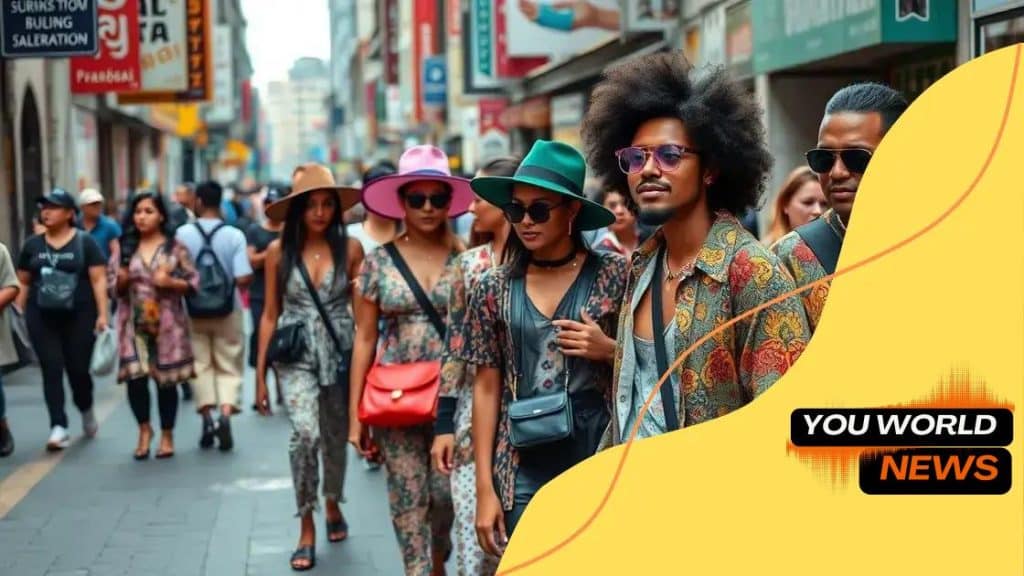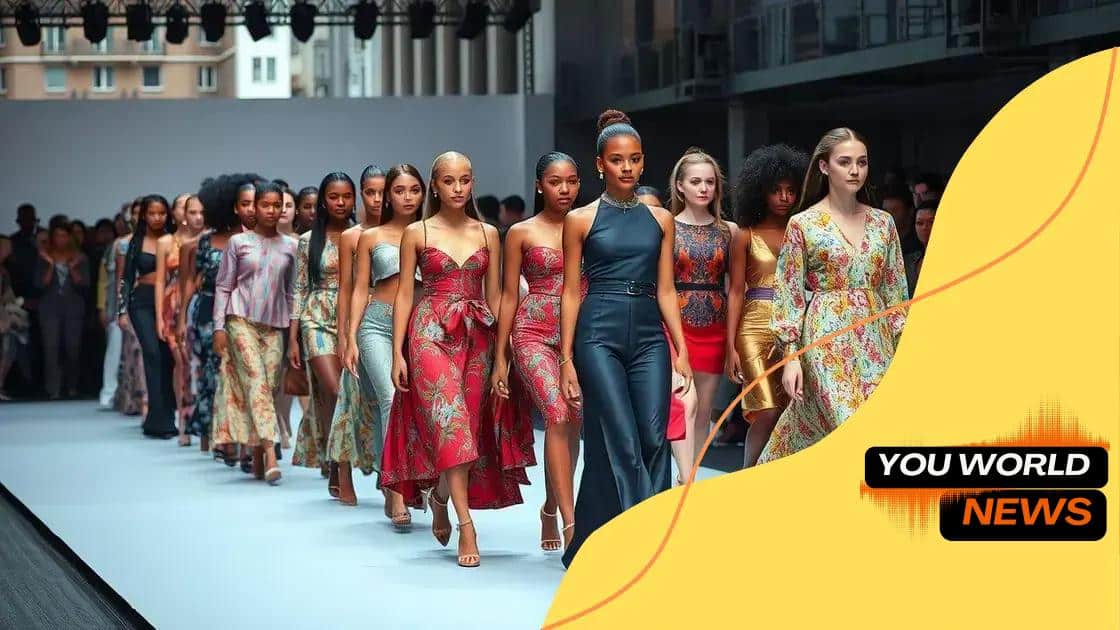Fashion’s role in promoting cultural diversity around the globe

Fashion plays a crucial role in promoting cultural diversity by embracing unique designs, empowering diverse designers, and fostering inclusivity, ultimately allowing consumers to connect with authentic cultural narratives.
Fashion’s role in promoting cultural diversity is more significant than ever. It not only reflects our identities but also champions inclusivity and understanding among different cultures. Curious about how these elements intertwine? Let’s dive in.
The impact of fashion on cultural representation
The impact of fashion on cultural representation is profound and multifaceted. Fashion not only mirrors our personal styles but also defines and shapes cultural narratives. This dynamic relationship highlights how the clothing we wear can express identity, values, and even beliefs.
Cultural Symbols in Fashion
Many cultures have unique symbols that are woven into their traditional attire. When these symbols are adopted in contemporary fashion, they tell stories of heritage and history. Integrating cultural elements into fashion allows for a broader understanding and appreciation among different communities.
- Traditional patterns and textiles can foster connection.
- Fashion can serve as a canvas for cultural storytelling.
- Redefining stereotypes through diverse representation in design.
For instance, indigenous patterns used in modern clothing celebrate rich histories while providing visibility to those cultures. This way, the wearer not only looks good but also embraces a narrative that honors a legacy.
The Role of Influencers and Designers
Influencers and designers play a crucial role in promoting cultural representation. They have the power to highlight lesser-known cultures or styles, bringing them to a global audience. When they choose to showcase diverse fashion, they set trends that others follow.
This visibility encourages availability and appreciation of various styles, which leads to greater acceptance of cultural differences. Fashion shows, for example, often feature models from different backgrounds wearing designs that celebrate their cultures. This act of representation can change perceptions and open dialogues.
- Designers collaborating with artisans from different cultures.
- Highlighting cultural fashion in media campaigns.
- Building inclusive fashion platforms.
As consumers, when we consciously support such initiatives, we contribute to a movement that values diversity in all forms. The choices we make in fashion can foster cultural exchange and understanding.
How designers embrace cultural motifs
Designers today play a significant role in how we perceive different cultures through fashion. By embracing cultural motifs, they explore expressions that go beyond mere aesthetics. Each piece becomes a canvas that tells the stories of various traditions and histories.
Integrating Cultural Elements
Many designers draw inspiration from traditional art forms, textiles, and symbols. This integration helps preserve cultural heritage while presenting it in a modern light. Designers travel to diverse regions, learning firsthand about local crafts and styles. This allows them to bring authentic influences into their collections.
- Using traditional weaving techniques in contemporary fashion.
- Highlighting cultural narratives through unique prints.
- Collaborating with local artisans for authentic designs.
By incorporating these elements, designers not only elevate their work but also honor the cultures they represent. Fashion becomes a bridge between past and present, connecting different generations and communities.
Storytelling through Clothing
When designers choose to feature cultural motifs, they engage in storytelling. Each garment has the potential to convey a message or a history. For example, clothing adorned with tribal patterns can celebrate the identity and spirit of indigenous peoples. This storytelling aspect allows wearers to connect emotionally with their attire.
Furthermore, it enhances global awareness as people become more familiar with different cultures through fashion. Sharing these stories fosters appreciation and love for cultural diversity, making clothing not just something to wear, but a statement of identity and respect.
- Every collection can spark conversations about culture.
- Fashion shows often showcase these stories to diverse audiences.
- Wearable art highlights the importance of cultural narratives.
Through these practices, designers contribute to a richer understanding of the world and promote inclusivity in the fashion industry. The journey of embracing cultural motifs brings forth a bright tapestry of creativity that celebrates our shared humanity.
The role of fashion weeks in showcasing diversity

Fashion weeks have become significant platforms for showcasing not only the latest trends but also the rich diversity of culture and style. They serve as stages where creativity and inclusivity collide, allowing designers from various backgrounds to present their unique perspectives.
Highlighting Diverse Designers
During fashion weeks, many designers of different ethnicities and backgrounds get the opportunity to shine. This exposure is crucial in an industry that has historically favored certain aesthetics. By embracing diversity, fashion weeks allow for a broader array of influence, which enriches the overall landscape of fashion.
- Emerging designers are given a platform to reach global audiences.
- Cultural narratives are shared through innovative designs.
- Fashion weeks facilitate cross-cultural collaborations.
This shift helps in dismantling stereotypes and creates a space for dialogue about what fashion truly represents in today’s society. The styles seen on the runways often reflect a fusion of cultures, celebrating the beauty of inclusivity.
Promoting Representation on the Runway
Representation in fashion is about more than just who walks the runway. It involves models of different races, sizes, and abilities. When audiences see diverse models, it reflects a more accurate picture of the world we live in. Fashion weeks that prioritize representation empower underrepresented communities.
Furthermore, this visibility encourages consumers to embrace their individuality and feel connected to fashion. When they see themselves represented, it enhances their engagement with the brands and designers. Fashion becomes a means of expression, allowing everyone to discover styles that resonate with their identity.
- Diverse casting broadens appeal and customer loyalty.
- Valuing all body types fosters positive self-image.
- Fashion weeks become a celebration of all cultural identities.
As the industry evolves, the emphasis on diversity at fashion weeks promotes a richer, more varied cultural conversation. It reinforces the idea that fashion can be a powerful tool for change, capable of bringing people together.
Consumer demand for culturally inspired fashion
The rising interest in culturally inspired fashion highlights the changing landscape of consumer preferences. Today, shoppers want more than just style; they crave products that reflect authentic cultural narratives and values. This trend signals a greater appreciation for diversity and craftsmanship.
Understanding Consumer Motivation
Many consumers are increasingly drawn to fashion that tells a story. They want to connect with the heritage behind their garments. This motivation goes beyond aesthetics; it reflects a desire for products that have meaning. By understanding the cultural significance of fashion, consumers feel a sense of belonging.
- Shoppers seek items that celebrate cultural heritages.
- They prefer brands that support ethical and sustainable practices.
- Unique designs that tell stories resonate more with modern customers.
As a result, brands are adapting by embracing these values in their collections. They collaborate with local artisans and integrate traditional techniques into modern designs. This not only enhances the uniqueness of their offerings but also fosters a greater connection between the consumer and the craft.
Trends in Culturally Inspired Fashion
Fashion shows and marketing campaigns increasingly feature culturally inspired elements. Designers are using vibrant colors, patterns, and motifs that reflect various cultures. This trend captures attention and creates a buzz, driving demand among consumers who seek diversity in their wardrobes.
Moreover, social media platforms amplify this demand as influencers showcase their culturally inspired outfits. This visibility encourages followers to embrace similar styles, further spreading awareness and appreciation of different cultures. As consumers share their unique looks online, it builds an inclusive community around fashion.
- Collaborations with cultural artists attract attention.
- Fashion can reflect social movements and cultural pride.
- Online platforms foster global connections between brands and consumers.
The appreciation for culturally inspired fashion reflects a longing for authenticity and a connection to our global society. Consumers are choosing to express themselves through garments that resonate with their identity, values, and experiences.
Challenges faced in cultural appropriation
The topic of cultural appropriation presents significant challenges within the fashion industry. Many designers struggle to navigate the line between inspiration and appropriation. This issue raises ethical questions about ownership and respect for cultural symbols.
Understanding Cultural Appropriation
Cultural appropriation occurs when elements of one culture are used by another, often without permission or understanding. This can lead to feelings of disrespect among marginalized communities. It’s crucial for designers to understand the nuances involved in borrowing cultural elements for their work.
- Misrepresentation can occur when symbols are taken out of context.
- Without proper attribution, cultural significance may be lost.
- Financial gains from appropriated culture can lead to exploitation.
The internet has amplified these discussions, making consumers more aware of the impacts of appropriation. People are now calling for more transparency and accountability from brands. They want to see ethical practices that honor the cultures from which fashion derives its inspiration.
Designer Responsibilities
Designers have a responsibility to engage respectfully with cultures. This involves thorough research and consultation with cultural representatives before incorporating traditional elements. Collaborating with artisans can provide authenticity and ensure that designs reflect cultural stories.
Brands that prioritize these practices often find a more engaged audience. Consumers appreciate authenticity and are likely to support brands that respect cultural boundaries. By investing in ethical practices, designers can transform potential backlash into opportunities for deeper connections with their audience.
- Creating awareness through collaborative projects promotes understanding.
- Respectful designs celebrate, rather than exploit, cultures.
- Ethical storytelling adds depth to fashion marketing.
Navigating the challenges of cultural appropriation is vital for anyone in the fashion industry. By approaching cultures with respect, designers can create truly innovative work that resonates with their values.
In conclusion, the influence of fashion on cultural diversity is profound and dynamic. It urges designers to be mindful of cultural practices and encourages consumers to embrace diverse styles. By promoting inclusive fashion, the industry can foster respect and understanding across different cultures. Ultimately, appreciating cultural diversity in fashion creates a more vibrant and creative world.
FAQ – Questions about fashion’s role in promoting cultural diversity
What is cultural appropriation in fashion?
Cultural appropriation occurs when elements from one culture are used by another without permission or understanding, often leading to disrespect and misrepresentation.
How can designers embrace cultural motifs responsibly?
Designers can embrace cultural motifs by conducting thorough research, collaborating with cultural representatives, and ensuring they honor the cultural significance behind the elements they use.
Why is consumer demand for culturally inspired fashion increasing?
Consumers are increasingly looking for fashion that reflects diverse cultural narratives and values, seeking authenticity and meaning in their clothing choices.
What role do fashion weeks play in promoting diversity?
Fashion weeks showcase diverse designers and models, highlighting a wide range of cultural influences and promoting inclusivity within the fashion industry.





